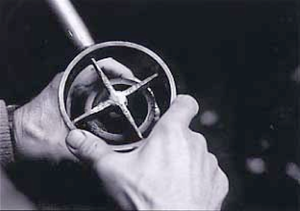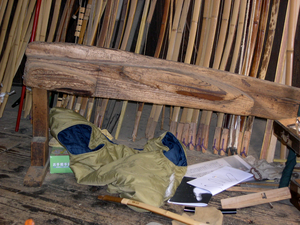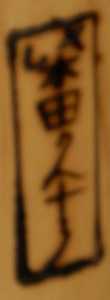The yumi, as it is made by Shibata Kanjuro XXI for kyudo practice, corresponds to the go mae higo, i.e. it has a naka uchi (middle part) made of four heat-hardened higo (bamboo slats), one wooden slat in the middle (maple) and two sobaki (outer woods - often haze > waxwood).
In addition, there is the elastic Todake (outer bamboo) and the hardened Uchidake (inner bamboo) which should not come from the same bamboo cane.
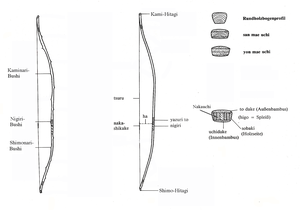 |
By the way, only the two "leaf sides" of the bamboo cane can be used. In the picture on the front side you can see the tool with which the bamboo is divided into four parts.
|
First the Naka uchi 中打 is glued and then planed into a complex shape.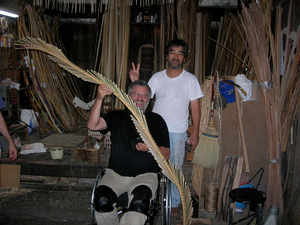 |
Uchidake (also called maedake) and todake are glued flat on the nakauchi (yumi uchi) together with kami no seki ita and shimo no seki ita (wooden ends at the top and bottom). The glue is pressed through a cord winding, which is tightened with bamboo wedges. As glue Shibata Kanjuro XXI usually needs a urea glue, which can bear climatic fluctuations well and is elastic. High-quality yumis are glued in steam with the nibe - にべ (a glue which is liquid under high temperature) made of deer skin. Superglue is also often used. |
| After gluing, the sides are roughly plastered and the ends rudimentarily carved. Then the yumi is stretched for the first time with a shinaitsuru (strong tendon) - a delicate act! Tense, the yumi remains still for a few days. Then its ends and sides are finished, finely sanded, polished with a boar's tooth on the side, grip leather and rattan attached and the master's signature is burned in: |
Here the ancient Haridai (wood tick) is used.
|
|
Signatures of Shibata Kanjuro XXI and his ancestors |
Signature of Don Symanski. His yumis no longer conform to the Shibata tradition. |






